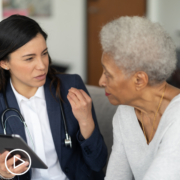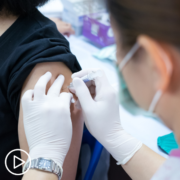How Do AML Patients and Outcomes Differ by Population Groups?
How Do AML Patients and Outcomes Differ by Population Groups? from Patient Empowerment Network on Vimeo.
How do AML genetic and molecular subtypes vary by population groups, and what are the impacts? Expert Dr. Sara Taveras Alam from UTHealth Houston discusses AML characteristics that impact some population groups and patient advice for overcoming barriers to AML care.
[ACT]IVATION Tip
“…communicate with your providers if you have any barriers to care, things like transportation, things like cost of medication may not seem to a patient as though they are important to bring up to the provider, but it is really important to bring up these barriers, as there’s things that may be done from the perspective of the hospital, perhaps they can connect you with financial assistance programs that may help with transportation, there’s different societies that can help with that, some of the pharmaceutical companies can help with that too…”
Related Resources:

|

Black and Latinx AML Patients | The Impact of Cultural Beliefs |

|
Transcript:
Lisa Hatfield:
Dr. Taveras, are there differences in the genetic and molecular subtypes of AML among different population groups, and how do these differences influence disease progression, response to treatment, and survival outcomes?
Dr. Sara Taveras Alam:
That is a great question. We know that in acute myeloid leukemia in general, the molecular characteristics and genetic characteristics are of prognostic and therapeutic value. We do know that Black patients have a higher risk of poor risk cytogenetics and a higher risk of not responding to treatment as well as a higher risk of complications from treatment. Some of my work actually also evaluated that Hispanic patients with comorbidities fared much worse than other populations with comorbidities.
So we always have to think about the patient as a whole and provide care that target the leukemia, but also take into consideration all of the characteristics of our patients that we’re serving. Some of our patients may have a higher difficulty accessing care or continuing care, obtaining their medication, and that too may impact their treatment outcomes.
My activation tip for this question would be to communicate with your providers if you have any barriers to care, things like transportation, things like cost of medication may not seem to a patient as though they are important to bring up to the provider, but it is really important to bring up these barriers, as there’s things that may be done from the perspective of the hospital, perhaps they can connect you with financial assistance programs that may help with transportation, there’s different societies that can help with that, some of the pharmaceutical companies can help with that too, so there are a lot of barriers to care that come from the patient socioeconomic circumstances, which is not necessarily specific to race or ethnicity, but may be associated since we know that some of our minorities will live in places where they’re below the poverty index, and if we don’t help them with these things, they might not have the best outcome.
Lisa Hatfield:
If you have a patient who does have some kind of barrier to access, whether it’s to their medications or to getting to treatment transportation, can they talk with you or the nurse, or is there a social worker at most facilities? Who would they mention that too, if they had an issue with access?
Dr. Sara Taveras Alam:
I think that the best thing is to mention it to everyone that you encounter in the healthcare system, definitely in terms the sense the social worker may take charge, connecting the patient with resources that are available. In my institution, we have a navigator that also helps connect patients to resources, but also as a provider, I’ve been in the position of sharing names and contacts of certain institutions that may be able to help the patient, I’m not sure if it’s appropriate to tell the name here, but there definitely may be things available for the patient that different members of the team may be knowledgeable about, so my recommendation would be to mention whatever barrier you have to each person that is connecting with you from your healthcare team, social worker, medical assistant, nurse, doctor. The more people you mention it to, the higher the likelihood, that it will be taken care of.



![[ACT]IVATED AML Resource Guide [ACT]IVATED AML Resource Guide](https://powerfulpatients.org/wp-content/uploads/ACTIVATED-AML-Resource-Guide-180x180.png)






